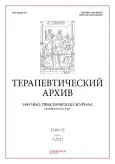Liver and COVID-19: possible mechanisms of damage
- Authors: Mnatsakanyan M.G.1, Pogromov A.P.1, Lishuta A.S.1, Fomin V.V.1, Volkova O.S.1, Tashchyan O.V.1, Kuprina I.V.1, Shumskaya Y.F.1
-
Affiliations:
- Sechenov First Moscow State Medical University (Sechenov University)
- Issue: Vol 93, No 4 (2021)
- Pages: 427-430
- Section: Original articles
- URL: https://journals.rcsi.science/0040-3660/article/view/71221
- DOI: https://doi.org/10.26442/00403660.2021.04.200733
- ID: 71221
Cite item
Full Text
Abstract
The global epidemic of a new coronavirus infection caused by SARS-CoV-2 is a major threat to human health. In the clinical picture, along with acute respiratory distress syndrome, liver lesions are also noted. The following mechanisms are currently being considered: direct damaging effects of SARS-CoV-2, immuno-mediated inflammation, hypoxia, drug exposure, and reactivation of pre-existing liver disease. We studied 150 patients with COVID-pneumonia who are under inpatient treatment at the University Clinical Hospital No. 1 of Sechenov First Moscow State Medical University. Of these, the presence of SARS-CoV-2 RNA was confirmed by polymerase chain reaction in 84 (56.0%) patients. In 55 (36.7%) patients, an increase in serum aminotransferases was registered, mainly alanine aminotransferase max. up to 572 U/L and aspartate aminotransferase up to a max. of 232 U/L. The long-term consequences are unknown and require monitoring of these patients.
Keywords
Full Text
##article.viewOnOriginalSite##About the authors
Marina G. Mnatsakanyan
Sechenov First Moscow State Medical University (Sechenov University)
Author for correspondence.
Email: mnatsakanyanmg@gmail.com
ORCID iD: 0000-0001-9337-7453
д.м.н., проф. каф. Госпитальной терапии №1 Института клинической медицины им. Н.В. Склифосовского, зав. гастроэнтерологическим отд-нием Университетской клинической больницы №1
Russian Federation, MoscowAleksandr P. Pogromov
Sechenov First Moscow State Medical University (Sechenov University)
Email: mnatsakanyanmg@gmail.com
ORCID iD: 0000-0002-7426-4055
д.м.н., проф. каф. госпитальной терапии №1 Института клинической медицины им. Н.В. Склифосовского
Russian Federation, MoscowAleksei S. Lishuta
Sechenov First Moscow State Medical University (Sechenov University)
Email: mnatsakanyanmg@gmail.com
ORCID iD: 0000-0003-3391-0193
к.м.н., доц. каф. госпитальной терапии №1 Института клинической медицины им. Н.В. Склифосовского
Russian Federation, MoscowVictor V. Fomin
Sechenov First Moscow State Medical University (Sechenov University)
Email: mnatsakanyanmg@gmail.com
ORCID iD: 0000-0002-2682-4417
чл.-кор. РАН, д.м.н., проф., проректор по клинической работе и дополнительному профессиональному образованию, зав. каф. факультетской терапии №1 Института клинической медицины им. Н.В. Склифосовского
Russian Federation, MoscowOlga S. Volkova
Sechenov First Moscow State Medical University (Sechenov University)
Email: mnatsakanyanmg@gmail.com
ORCID iD: 0000-0002-4568-1298
к.м.н., дир. Клинического центра
Russian Federation, MoscowOlga V. Tashchyan
Sechenov First Moscow State Medical University (Sechenov University)
Email: mnatsakanyanmg@gmail.com
ORCID iD: 0000-0001-6759-6820
к.м.н., врач-гастроэнтеролог гастроэнтерологического отд-ния Университетской клинической больницы №1
Russian Federation, MoscowIrina V. Kuprina
Sechenov First Moscow State Medical University (Sechenov University)
Email: mnatsakanyanmg@gmail.com
ORCID iD: 0000-0002-5854-8082
к.м.н., врач-гастроэнтеролог гастроэнтерологического отд-ния Университетской клинической больницы №1
Russian Federation, MoscowYuliia F. Shumskaya
Sechenov First Moscow State Medical University (Sechenov University)
Email: mnatsakanyanmg@gmail.com
ORCID iD: 0000-0002-8521-4045
ординатор каф. госпитальной терапии №1 ИКМ им. Н.В. Склифосовского
Russian Federation, MoscowReferences
- Pan L, Mu M, Ren HG, on behalf of the Wuhan Medical Treatment Expert Group for COVID-19 Clinical characteristics of COVID-19 patients with digestive symptoms in Hubei, China: a descriptive, cross-sectional, multicenter study. Am J Gastroenterol. 2020. doi: 10.14309/ajg.0000000000000620
- Guan W, Ni Z, Hu Y. Clinical characteristics of coronavirus disease 2019 in China. N Engl J Med. 2020. doi: 10.1056/NEJMoa2002032
- Wang D, Hu B, Hu C. Clinical characteristics of 138 hospitalized patients with 2019 novel coronavirus – infected pneumonia in Wuhan, China. JAMA. 2020. doi: 10.1001/jama.2020.1585
- Yeo C, Kaushal S, Yeo D. Enteric involvement of coronaviruses: is faecal–oral transmission of SARS-CoV-2 possible? Lancet Gastroenterol Hepatol. 2020. doi: 10.1016/S2468-1253(20)30048-0
- Feng G, Zheng KI, Yan Q-Q, et al. COVID-19 and Liver dysfunction: current insights and emergent therapeutic strategies. J Clin Transl Hepatol. 2020;8:18-24.
- Garrido I, Liberal R, Macedo G. Review article: COVID-19 and liver disease-what we know on 1st May 2020 [published online ahead of print, 2020 May 13]. Aliment Pharmacol Ther. 2020. doi: 10.1111/apt.15813
- Mao R, Qiu Y, He Jin-Shen, et al. Manifestations and prognosis of gastrointestinal and liver involvement in patients with COVID-19: a systematic review and meta-analysis. Lancet Gastroenterol Hepatol. 2020. doi: 10.1016/S2468-1253(20)30126-6
- Chai X, Hu L, Zhang Y. Specific ACE2 expression in cholangiocytes may cause liver damage after 2019-nCoV infection. bioRxiv. 2020. Published online Feb 4. (preprint). doi: 10.1101/2020.02.03.931766
- Sun J, Aghemo A, Forner A, Valenti L. COVID-19 and liver disease. Liver International. 2020;40:1278-81.
- Zhang C, Shi L, Wang F-S. Liver injury in COVID-19: management and challenges. Lancet Gastroenterol Hepatol. 2020;5(5):428-30.
- Fries JF, Singh G, Lenert L, Furst DE. Aspirin, hydroxychloroquine, and hepatic enzyme abnormalities with methotrexate in rheumatoid arthritis. Arthritis Rheum.1990;33:1611-9.
- Sulkowski MS. Drug-induced liver injury associated with antiretroviral therapy that includes HIV-1 protease inhibitors. Clin Infect Dis. 2004;38:S90-S97.
- Casado JL, Del Palacio M, Moya J, et al. Safety and pharmacokinetics of lopinavir in HIV/HCV coinfected patients with advanced liver disease. HIV Clin Trials. 2011;12:235-43.
- Liu C, Jiang ZC, Shao CX, et al. Preliminary Study of the Relationship Between Novel Coronavirus Pneumonia and Liver Function Damage: A Multicenter Study. Zhonghua Gan Zang Bing Za Zhi. 2020;28(2):107-11. doi: 10.3760/cma.j.issn.1007-3418.2020.02.003
- Boettler T, Newsome PN, Mondelli MU, et al. Care of patients with liver disease during the COVID-19 pandemic: EASL-ESCMID position paper. JHEP Rep. 2020;2(3):100113.
- Schütte A, Ciesek S, Wedemeyer H, Lange CM. Influenza virus infection as precipitating event of acute-on-chronic liver failure. J Hepatol. 2019;70:797-9.
- Xiao Y, Pan H, She Q, et al. Prevention of SARS-CoV-2 infection in patients with decompensated cirrhosis. Lancet Gastroenterol Hepatol. 2020;5:528-9.
- Зайратьянц О.В., Cамсонова М.В., Михалева Л.М., и др. Под общ. ред. О.В. Зайратьянца. Патологическая анатомия COVID-19. Атлас. М.: Департамент здравоохранения г. Москвы, 2020. [Zairatyants OV, Samsonova MV, Mihaleva LM, et al. Pathological anatomy of the COVID-19. Atlas. Moscow: Departament zdravookhraneniia g. Moskvy, 2020 (In Russ.)].
- Xu Z, Shi L, Wang Y. Pathological findings of COVID-19 associated with acute respiratory distress syndrome. Lancet Respir Med. 2020. Published online Feb 18. doi: 10.1016/S2213-2600(20)30076-X
- Zhang Y, Zheng L, Liu L, et al. Liver impairment in COVID-19 patients: a retrospective analysis of 115 cases from a single center in Wuhan city, China. Liver Int. 2020. doi: 10.1111/liv.14455
Supplementary files







